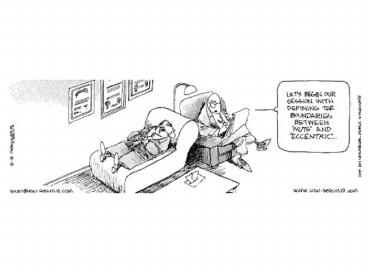Untitled - PowerPoint PPT Presentation
Title:
Untitled
Description:
Untitled – PowerPoint PPT presentation
Number of Views:117
Avg rating:3.0/5.0
Title: Untitled
1
(No Transcript)
2
Mood Disorders Overview
- Chapter 6
3
An Overview of Mood Disorders
- Extremes in Normal Mood
- Nature of depression
- Nature of mania and hypomania
- Types of DSM-IV Depressive Disorders
- Major depressive disorder
- Dysthymic disorder
- Double depression
- Types of DSM-IV Bipolar Disorders
- Bipolar I disorder
- Bipolar II disorder
- Cyclothymic disorder
4
Nature of Depressive Episodes
- Major Depressive Episode
- Extremely depressed mood state lasting at least 2
weeks - Cognitive symptoms
- Feelings of worthlessness, inappropriate guilt,
diminished concentration or thinking, and
preoccupation with death - Vegetative or somatic symptoms
- Change in weight or appetite, change in sleep,
psychomotor changes, and fatigue - Anhedonia Loss of pleasure/interest in usual
activities
5
Nature of Manic Episodes
- Distinctly elevated or irritable mood lasting at
least one week - Three or more of the following
- Inflated self-esteem or grandiosity
- Decreased need for sleep
- Talkativeness, pressured speech
- Flight of ideas or racing thoughts
- Distractibility
- Increased goal-directed activity or agitation
- Excessive involvement in pleasurable activities
that are likely to have painful consequences
6
Nature of Hypomanic and Mixed Episodes
- Hypomanic episodes
- Same criteria as manic episodes, but duration
only 4 days, and does not require clinical
impairment of functioning - Mixed episodes
- Meet criteria for both depressive and manic
episode (except duration)
7
Major Depressive Disorder Overview
- Requires presence of major depressive episode
- No history of manic, hypomanic, or mixed episode
- Single episode Highly unusual
- Recurrent episodes More common
- Statistics
- Point prevalence peaks in middle adulthood (7.5)
- Lifetime prevalence 10-25 for women, 5-12 for
men
8
Dysthymia An Overview
- Overview and Defining Features
- Defined by persistently depressed mood that
continues for at least 2 years - Symptoms of depression are milder than major
depression - Symptoms can persist unchanged over long periods
(e.g., 20 years or more) - Facts and Statistics
- Late onset Typically in the early 20s
- Early onset Before age 20, greater chronicity,
poorer prognosis - Lifetime prevalence 6, point prevalence 3
9
Double Depression An Overview
- Overview and Defining Features
- Person experiences major depressive episodes and
dysthymic disorder - Dysthymic disorder often develops first
- Facts and Statistics
- Associated with severe psychopathology
- Associated with a problematic future course
10
Bipolar I Disorder An Overview
- Overview and Defining Features
- Alternations between full manic episodes and
depressive episodes - Facts and Statistics
- Average age on onset is 18 years, but can begin
in childhood, rarely after age 40 - Tends to be chronic
- Suicide is a common consequence (9-60, average
estimate 19) - Lifetime prevalence 0.4 1.6
11
Bipolar II Disorder An Overview
- Overview and Defining Features
- Alternations between major depressive episodes
and hypomanic episodes - Facts and Statistics
- Average age of onset is 22 years, but can begin
in childhood - Only 10 to 13 of cases progress to full bipolar
I disorder - Tends to be chronic
12
Cyclothymic Disorder An Overview
- Overview and Defining Features
- More chronic version of bipolar disorder
- Manic and major depressive episodes are less
severe - Manic or depressive mood states persist for long
periods - Pattern must last for at least 2 years (1 year
for children and adolescents) - Facts and Statistics
- Average age of onset is about 12 or 14 years
- Cyclothymia tends to be chronic and lifelong
- Most are female
- High risk for developing bipolar I or II disorder
13
Additional Defining Criteria for Mood Disorders
- Symptom Specifiers
- Melancholic (40-60)
- Depression worse in the morning, insomnia with
early waking, anorexia and significant weight
loss, anhedonia - Atypical (15)
- Depression worse at night, oversleeping,
overeating and significant weight gain - Chronic Major depression only, lasting 2 years
- Catatonic Very serious condition, absence of
movement - Psychotic Mood congruent/incongruent
hallucinations/delusions - Postpartum Severe manic or depressive episodes
post childbirth
14
Additional Defining Criteria for Mood Disorders
(cont.)
- Course Specifiers
- Longitudinal course Past history and recovery
from depression and/or mania - Rapid cycling pattern Applies to bipolar I and
II disorder only - Seasonal pattern Whether episodes are more
likely during a certain season































